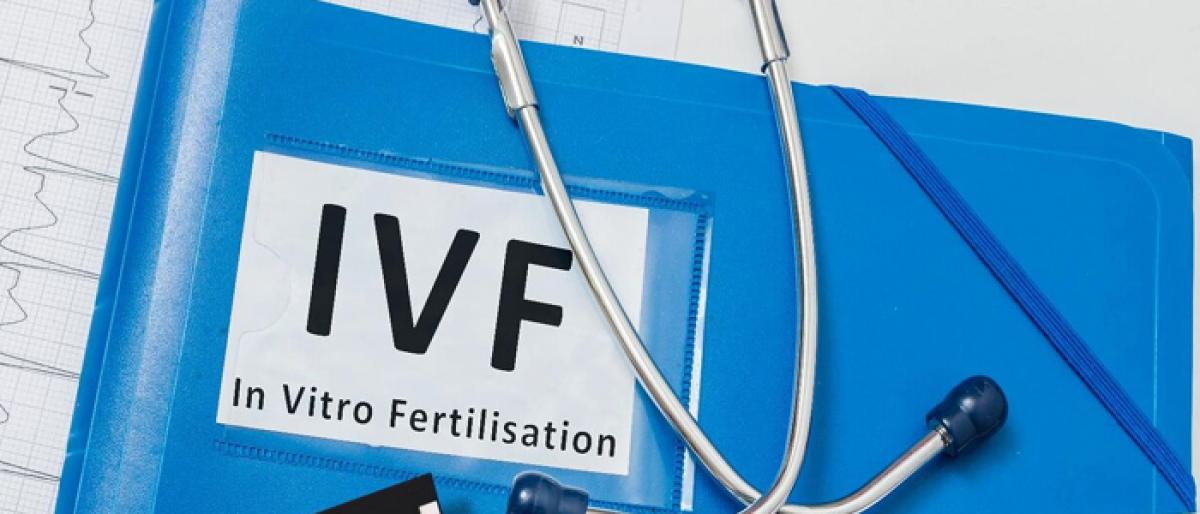Live
- AAP Announces Final Candidate List For 2025 Delhi Assembly Elections, Kejriwal To Contest From New Delhi
- Bangladesh unrest has delayed execution of some vital projects: Tripura CM
- PIL in SC seeks direction to designate BMC as sole planning, sanctioning authority for Mumbai
- 3rd Test: Centuries from Head, Smith help dominant Australia feast on listless India
- AAP final list of 38 names in Delhi: Kejriwal, CM Atishi retain seats
- Tributes Paid to Sardar Vallabhbhai Patel on His Death Anniversary at CM Revanth Reddy's Residence
- In just one year, Bhajanlal govt wins hearts of people
- CM Chandrababu announces establishment of Potti Sriramulu Telugu University
- Sutume, Kissa win World 25K Kolkata; India's Gulveer makes course record
- US accounts for 18 per cent of Indian exports in FY24
Just In

It is like their worst fear has been realized the moment a couple finds out that they will have to seek medical treatment to help them get pregnant The mere thought of undergoing an infertility procedure ART, assisted reproductive technology such as IVF can be a daunting and emotionally draining experience, especially when there are lots of uncertainties around the treatment and what it may ent
It is like their worst fear has been realized the moment a couple finds out that they will have to seek medical treatment to help them get pregnant. The mere thought of undergoing an infertility procedure (ART, assisted reproductive technology such as IVF) can be a daunting and emotionally draining experience, especially when there are lots of uncertainties around the treatment and what it may entail.
In many cases, women find it difficult to share their fears and concerns as they often feel embarrassed and ashamed about their situation.
The term ‘in vitro’ means outside the body. Hence, In vitro fertilization (IVF) means “The fertilisation of woman’s egg and her partner’s sperm outside the woman’s body”. In this process the female eggs(oocytes) and the male sperms are joined (fertilized) in the laboratory and then the fertilized eggs(embryos) are transferred into the womb.
Fears related to IVF treatment
Birth Defects
One of the most common fears remain about the health of the baby as IVF can seem far remote from “natural” conception, and some women worry that this difference will continue into the pregnancy.
In a study conducted by medical researcher at the US centers of Disease Control and Prevention, it was found that children born through the use of assisted technologies are healthy and normal. The research revealed number of birth defects was actually higher in children born naturally than in those using other techniques and reproductive technology. The natural birth group had 45 documented defects while the artificially birthed group only found 25.
The incidence of congenital malformation in IVF pregnancies ranges between 2 to 3% world-wide and is similar to that in babies born following natural conception.
In addition to above, Newer technologies has arrived like ‘Pre Genetic Screening’ in which the embryos are tested for any chromosomal anomalies before their transfer and then only the selected euploid (normal) embryos are transferred. This technique is highly helpful for those couples who have a prior history of pregnancy with birth defects.
Multiple Births
Many experts have found that woman often come with preconceived notion that they will give birth to multiple children with IVF. Though, there is a base to their worries as earlier such cases used to happen; due to advancements in ART, chances of multiple pregnancies have been reduced considerably.
“On an average, 21% of pregnancies through IVF or ICSI result in twins and 1% results in triplets, however the chances of this can be significantly reduced depending on the type of fertility treatment is used
Premature Menopause
Based on many patients’ testimonials, it has also been discovered that many women remain concerned about their ovarian reserve. Since during the treatment, a large number of eggs are removed which feeds into the notion that this might deplete their ovarian reserve faster, causing them to come into premature menopause.
Experts assure that this is merely a myth. First, we should understand few facts about ovaries.
In the ovaries there are antral and pre-antral follicles. During each ovulation cycle only the antral follicles begin to grow and out of which only one becomes dominant and ovulate. The rest of the recruited follicles undergo regression and are lost. During the IVF process, the effects of stimulation is only to the antral follicles which are recruited physiologically for the cycle. The eggs retrieved (mostly around 10 to 15 in number) are those eggs which would otherwise have been regressed/lost in a natural cycle. IVF doesn’t effect your pre antral follicles and hence your ovarian store remains undisturbed.
Bed Rest Needed After IVF
Need for bed rest post IVF is one of the biggest fear of couples who are going for it. Studies have shown that the success of IVF are better in patients who follow their routine life post embryo transfer as compared to those who remains in bed .
It may look like a rollercoaster emotional ride but it gets better once you have decided to let go off your fears. Nothing would seem safe or real until you hold you little one in your arms and feel for yourself. And then you will feel that all your anxieties and worries have come to rest.
Happy Parenting
Dr. Swati Mothe, Consultant Gynaecologist, Indira IVF, Hyderabad

© 2024 Hyderabad Media House Limited/The Hans India. All rights reserved. Powered by hocalwire.com







